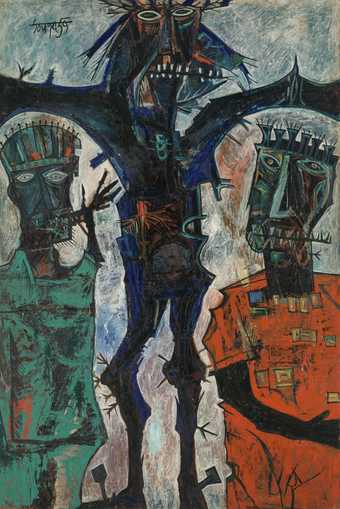
F.N. Souza, Crucifixion 1959. Tate. © The estate of F.N. Souza/DACS, London 2024.
Fear and Freedom 1940–1965
13 rooms in Modern and Contemporary British Art
The Post-War era is one of immense social change and dramatic geopolitical realignment. Artists give visual expression to the experiences of loss, destruction and displacement, yet also to independence and freedom
The Second World War is the deadliest conflict in human history. Upwards of 85 million people die, mostly civilians. Six million European Jews are murdered by Nazi Germany, alongside other persecuted people. Colonial empires are dismantled and new superpowers – the Soviet Union and the United States – arise. They bring the threat of global nuclear annihilation. The war’s aftermath is a period of existential crisis and dread. It is also an era of freedom, as old beliefs and certainties are shattered, and former colonies in Africa, Asia and the Caribbean become independent nations.
Artists respond in different ways to the experience of the war and its consequences. The body, in all its vulnerability, is a major subject. Some artists produce intensely observed and expressive representations of the human figure. Others create landscapes and cityscapes marked by combat, displacement or alienation, conveying a sense of turbulence.
After the war, Britain calls for people from the Commonwealth to help rebuild the ‘motherland’. The first of the Windrush generation arrive from the Caribbean in 1948. Many are greeted with discrimination. Other people flee conflict: up to a million people lose their lives in violence when Britain divides India along religious and ethnic lines ahead of independence in 1948. Artists arrive from all over the world, working, studying and teaching in Britain. Some reflect the spirit of decolonisation in their radically modern paintings and sculpture.
Peter Lanyon, St Just 1953
Lanyon named this painting for St Just-in- Penwith, the small, grey town that was the historic centre of the west Cornwall tin mining industry. Initially conceived as a crucifixion, Lanyon quickly associated this work with the tragic history of the mining district that runs west of St Ives towards St Just, as well as with mythological symbols of death and renewal. This painting was the culmination of a series of works made from late 1951 to 1954 in which Lanyon layered successive coats of thick paint in complex, tangled compositions that suggest landscapes with a symbolic meaning.
Gallery label, September 2016
1/26
artworks in Fear and Freedom
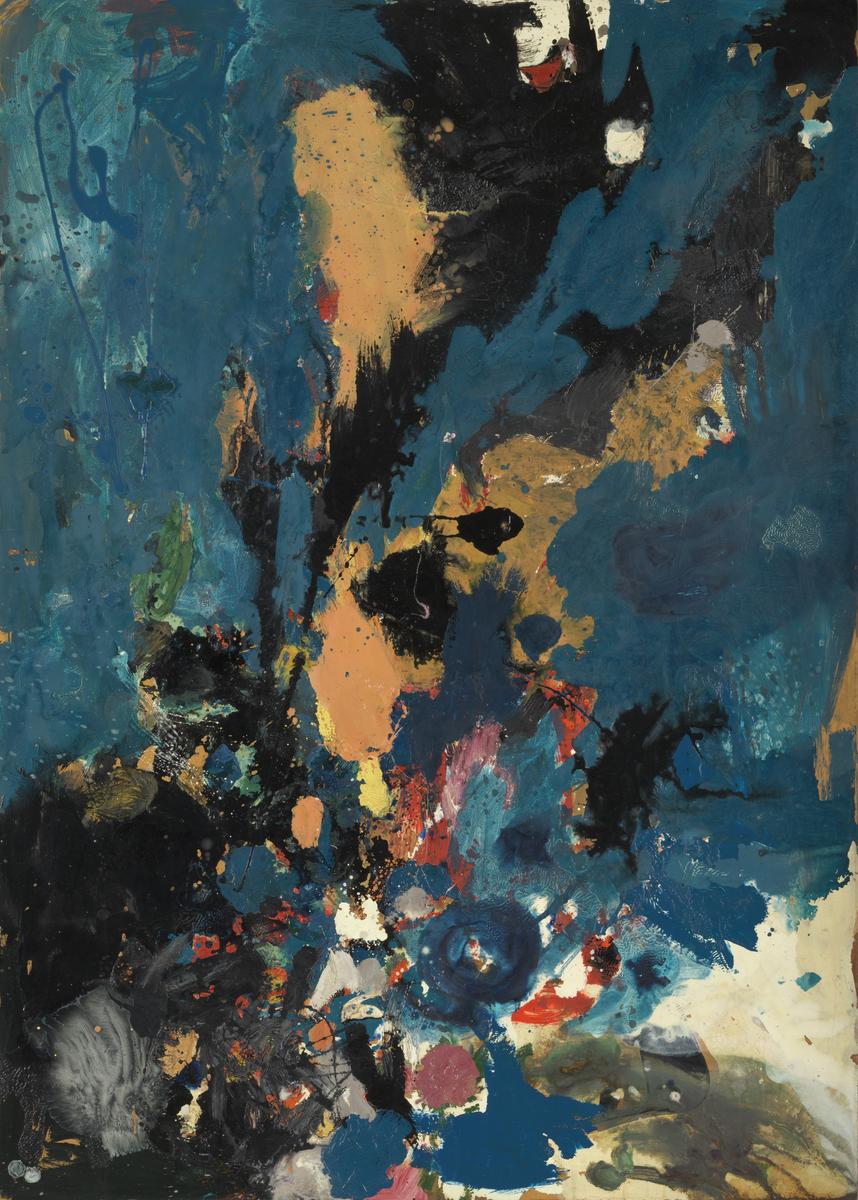
Gillian Ayres CBE RA, Distillation 1957
Distillation was painted partly in household enamel and partly in artist’s oil paint. Ayres applied the paint with rags and brushes, and by pouring from the can and squirting from the tube. Influenced by photographs of the North American abstract expressionist painter Jackson Pollock making his drip paintings, she worked on this painting while it was flat on the floor. Ayres kept the paint fluid by dissolving it with a solvent, allowing her to manipulate it rapidly and spontaneously. Her main concerns at this time were space, materials and colour, and balancing these ‘so that nothing is more important than anything else. One was into the idea of no composition...’
Gallery label, April 2019
2/26
artworks in Fear and Freedom
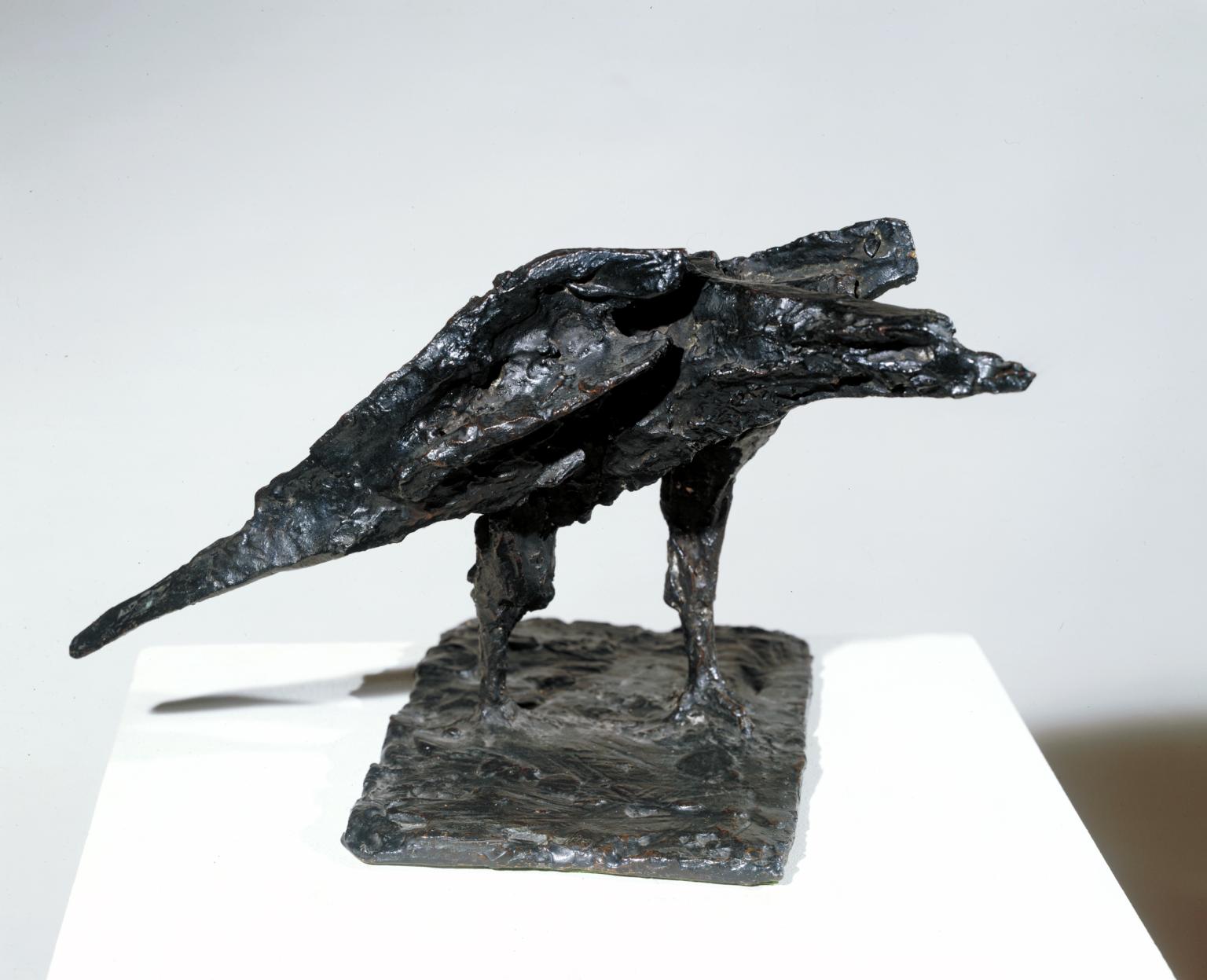
Dame Elisabeth Frink, Bird 1952
This strong, alert bird is one of Elizabeth Frink’s earliest sculptures. She continued to explore the bird theme over the next two decades. ‘In their emphasis on beak, claws and wings… they were really vehicles for strong feelings of panic, tension, aggression and predatoriness,’ she said. But she resisted symbolic readings of these works. She cautioned: ‘They certainly were not surrogates for human beings or “states of being”.’
Gallery label, September 2023
3/26
artworks in Fear and Freedom
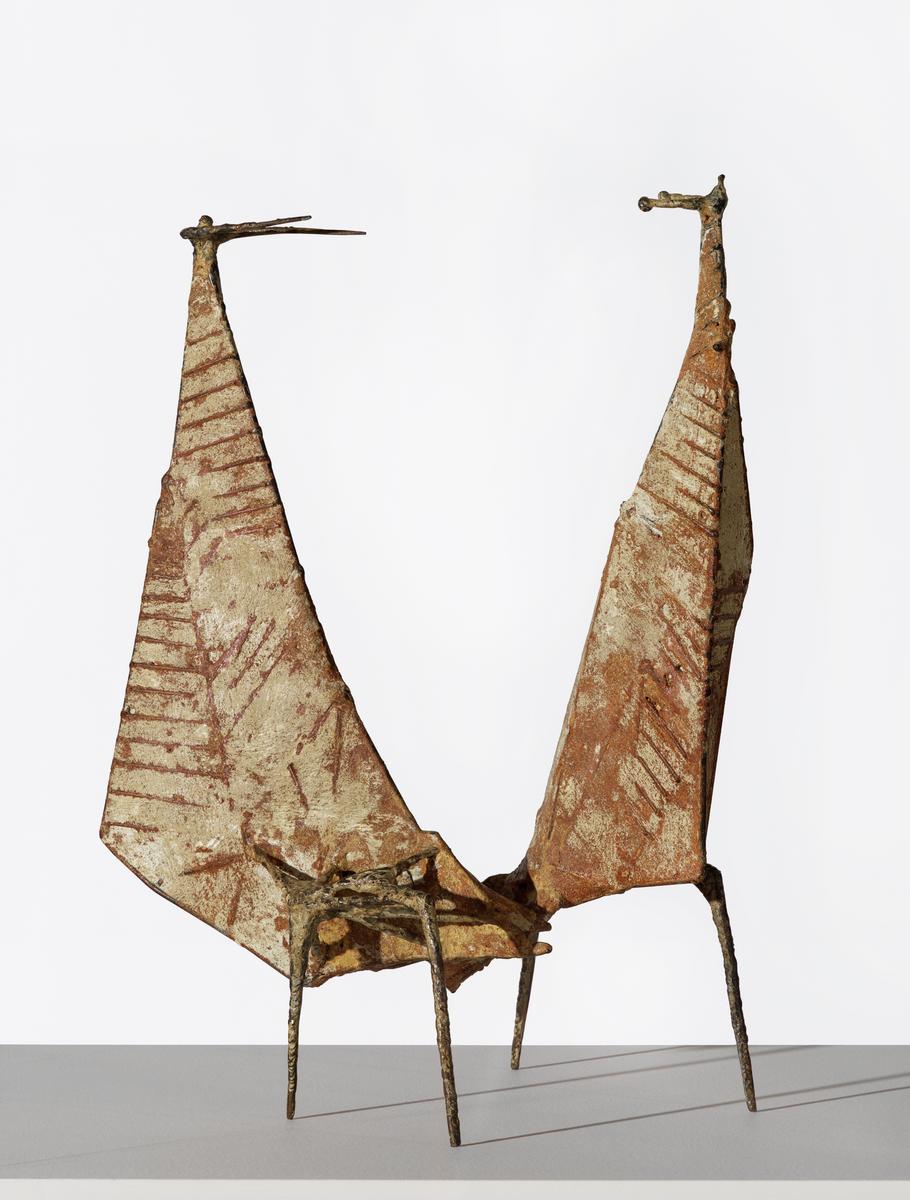
Lynn Chadwick, Conjunction 1953
Conjunction shows two abstracted figures in movement. Balanced on spindly insect-like legs and with beak like heads, they seem to suggest the underlying animal nature of humans. This is one of Lynn Chadwick’s first sculptures of a human couple. His main subject had previously been animals. After the Second World War, where he served as a pilot, Chadwick trained in welding. He then welded together iron rods with a material called Stolit, a mixture of plaster and powdered iron. The powdered iron on the surface has rusted, as Chadwick intended. This gives the sculpture its colour.
Gallery label, September 2023
4/26
artworks in Fear and Freedom
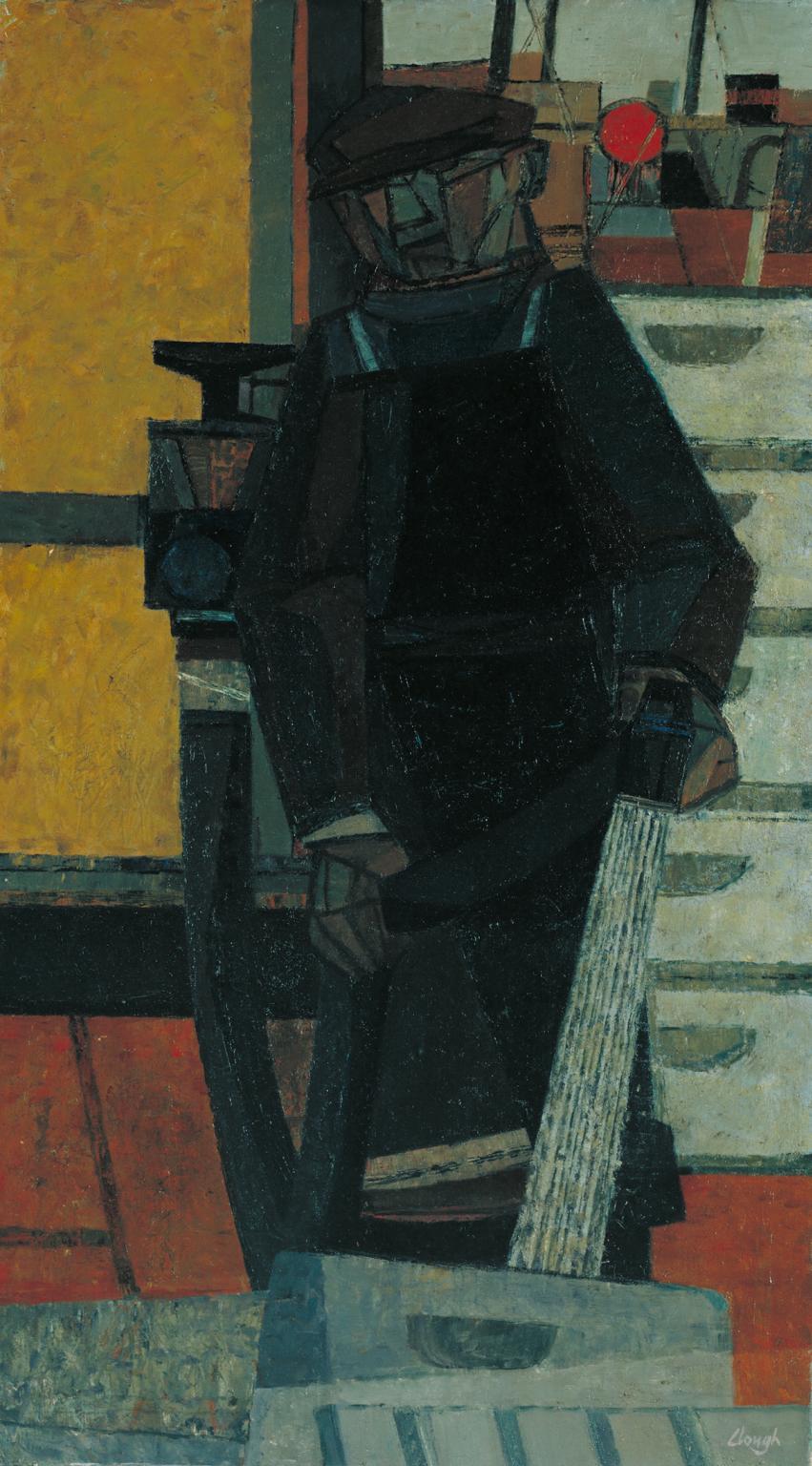
Prunella Clough, Man Hosing Metal Fish Boxes 1951
In the late 1940s and early 1950s, Prunella Clough often depicted working men. The figure here was probably inspired by people she observed on her visit to the fishing ports of East Anglia, but it doesn’t depict a particular individual.. Instead, she presents a man undertaking a specific task as something more universal. Art historians have interpreted the work in different ways. Some have seen it as showing the dehumanising effect of work in an industrial age. For others, it expresses ‘the dignity and value of labour’.
Gallery label, September 2023
5/26
artworks in Fear and Freedom
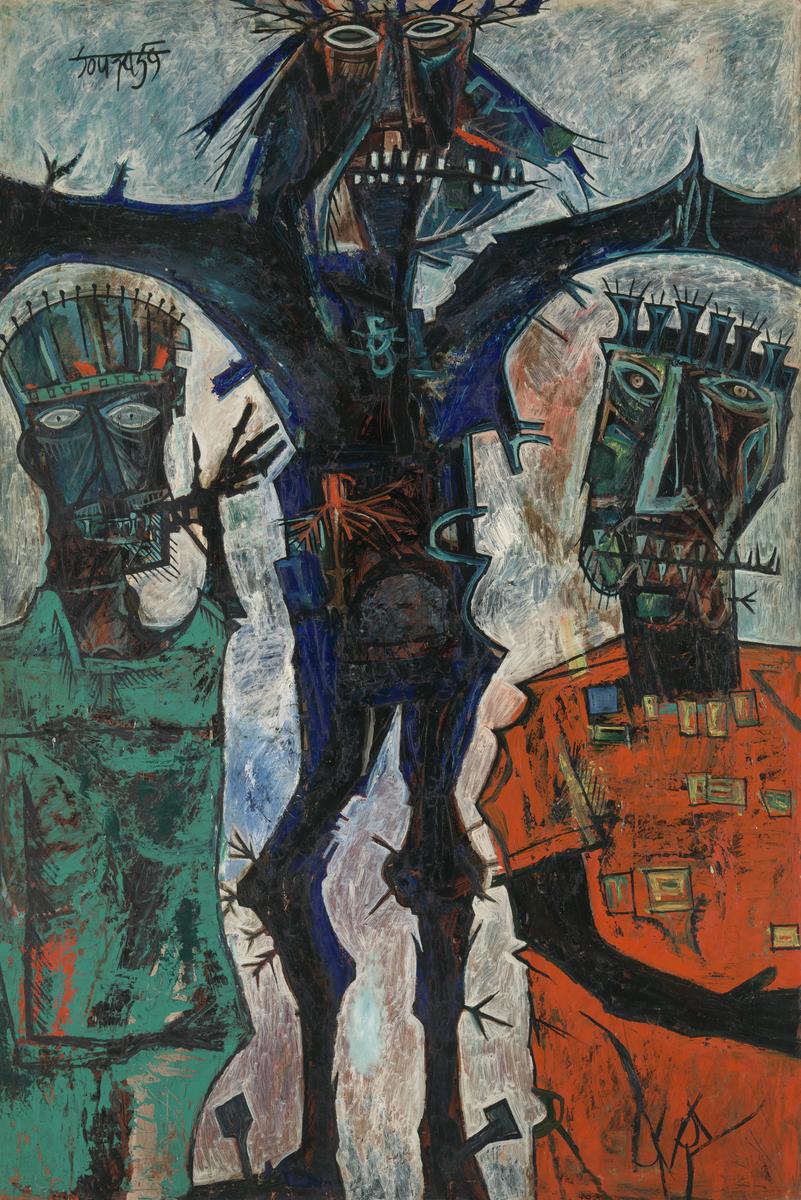
F.N. Souza, Crucifixion 1959
Brought up as a Roman Catholic, FN Souza’s faith became strained as he developed his secular understanding of life and suffering. Crucifixion presents Christ as a masked skeletal figure in dense black and dark blue pigments. His limbs are pinned to the outer edges of the frame to become the cross itself. The image relates to the artist’s personal religious struggle. Art historians have also discussed the painting in relation to the post-colonial condition, the contradiction of inherited faith and the deconstructed form of Modern European painting.
Gallery label, September 2023
6/26
artworks in Fear and Freedom
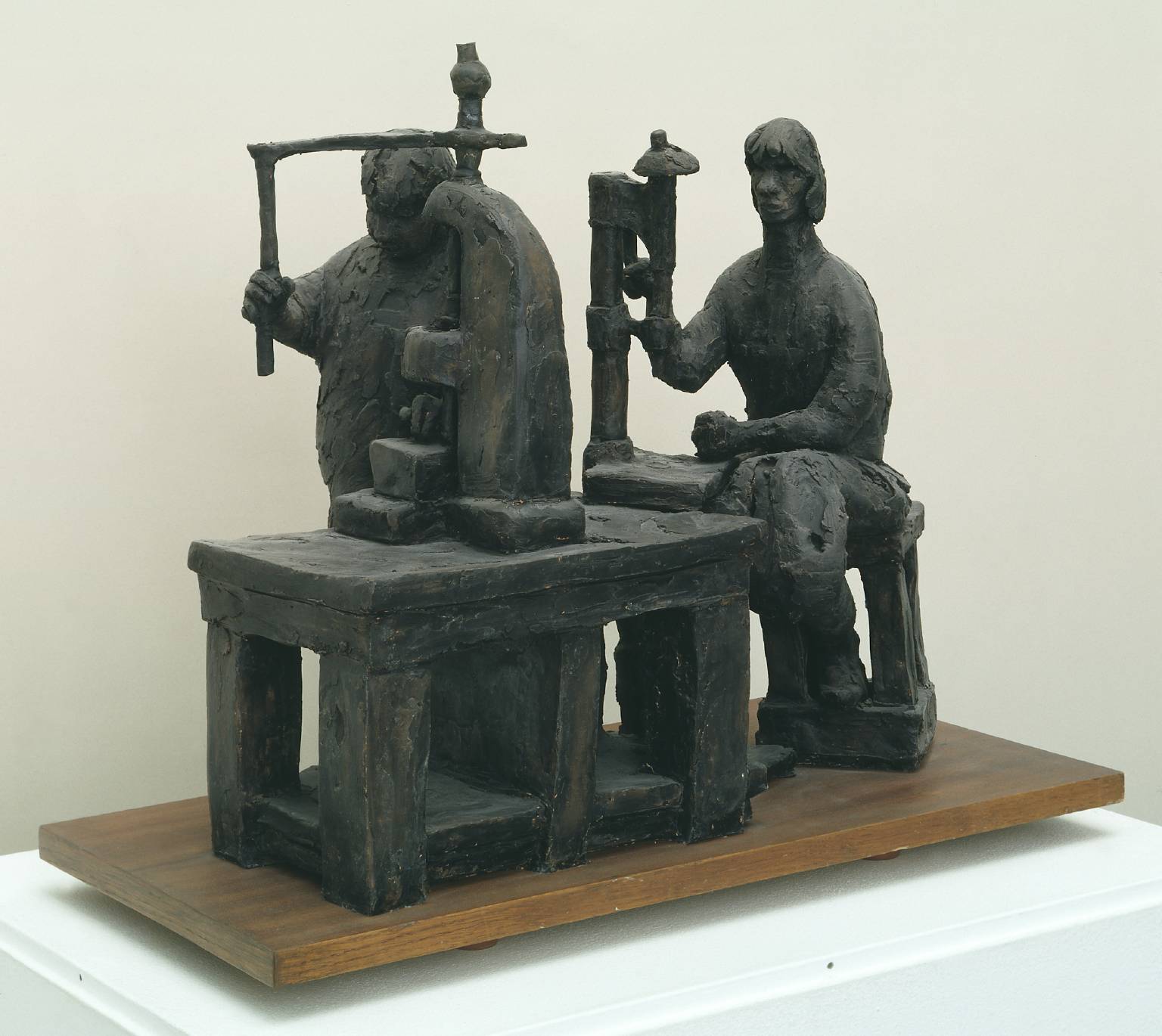
Ghisha Koenig, Metal Punchers I 1957
Ghisha Koenig was interested in the lives of factory workers. As she had no direct experience of this kind of job, she visited factories around England, sometimes for months at a time, where she spent many hours drawing what she saw. Her drawings were the source material for sculptures. These depict the experience of workers, the repetitive tasks and long days spent standing in the same position. Koenig wanted them to be truthful records of the endurance and monotony of factory life.
Gallery label, September 2023
7/26
artworks in Fear and Freedom

Lucian Freud, Girl with a Kitten 1947
This is one of eight portraits that Freud made of his first wife, the artist Kathleen (‘Kitty’) Garman (1926–2011). Freud sat very close to his subjects while painting them. Here he pays almost forensic attention to Garman, from the reflections in her pupils to the static energy of her wavy hair. In this psychologically charged composition, Garman holds a kitten by its neck in a tense grip, her white knuckles especially prominent.
Gallery label, September 2023
8/26
artworks in Fear and Freedom
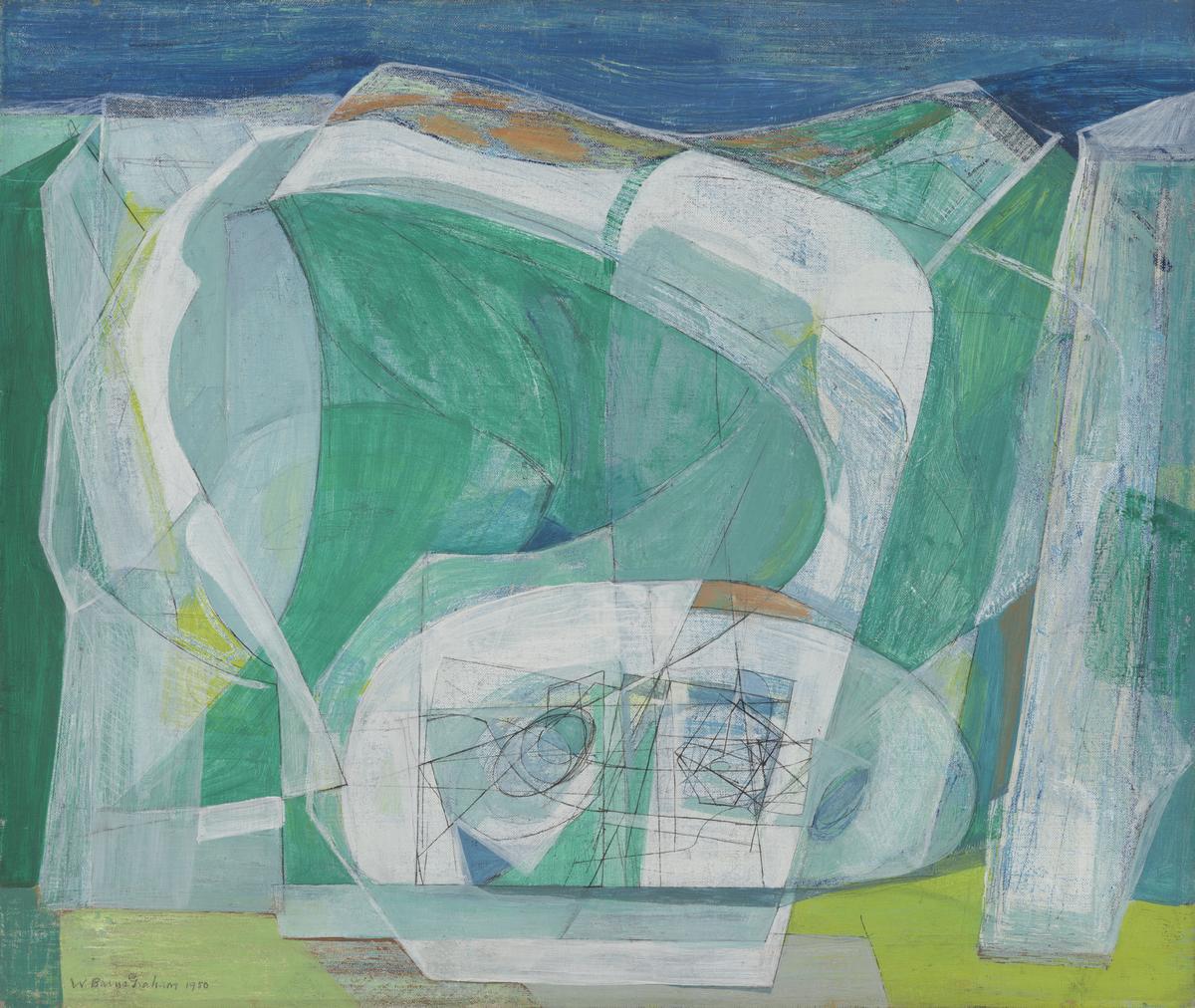
Wilhelmina Barns-Graham, Glacier Crystal, Grindelwald 1950
Wilhemina Barns-Graham’s art expresses the experience of being part of nature, rather than viewing the natural world from outside. She combined this with the influence of geometric abstraction. Barns-Graham made this work following a visit to the Grindelwald Glacier in Switzerland in 1948. There, she experienced the monumental shape of the glacier, as well as its light and the contrast between solidity and transparency. This led her to attempt to combine multiple views, ‘from above, through and all round, as a bird flies, a total experience.’
Gallery label, September 2023
9/26
artworks in Fear and Freedom
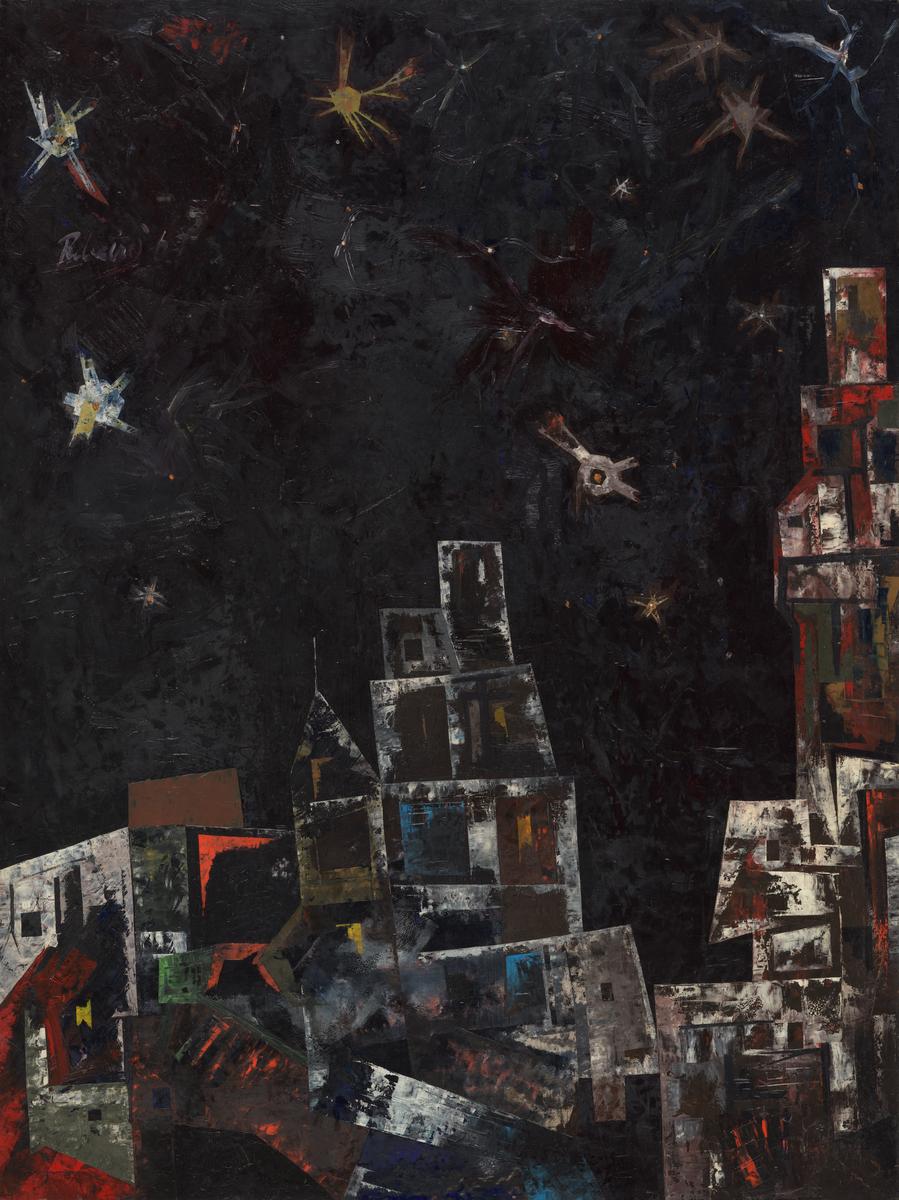
Lancelot Ribeiro, Cityscape (Night) 1963
Born in Mumbai (Bombay), India in 1933, Ribeiro moved to London in 1950. The night sky dominates much of this painting, appearing as an expansive black field scattered with twinkling white and yellow stars. Beneath the sky, stacked geometric shapes form oddly-angled towers. Landscapes are a major theme throughout Ribeiro’s work, particularly in the late 1950s and early 1960s. Ribeiro said, ‘None of these landscapes are of actual places but a sort of collective experience... my first influences... were the churches and statuary of the Catholic church in Goa along with the symbolic ritual that went with it’.
Gallery label, October 2022
10/26
artworks in Fear and Freedom
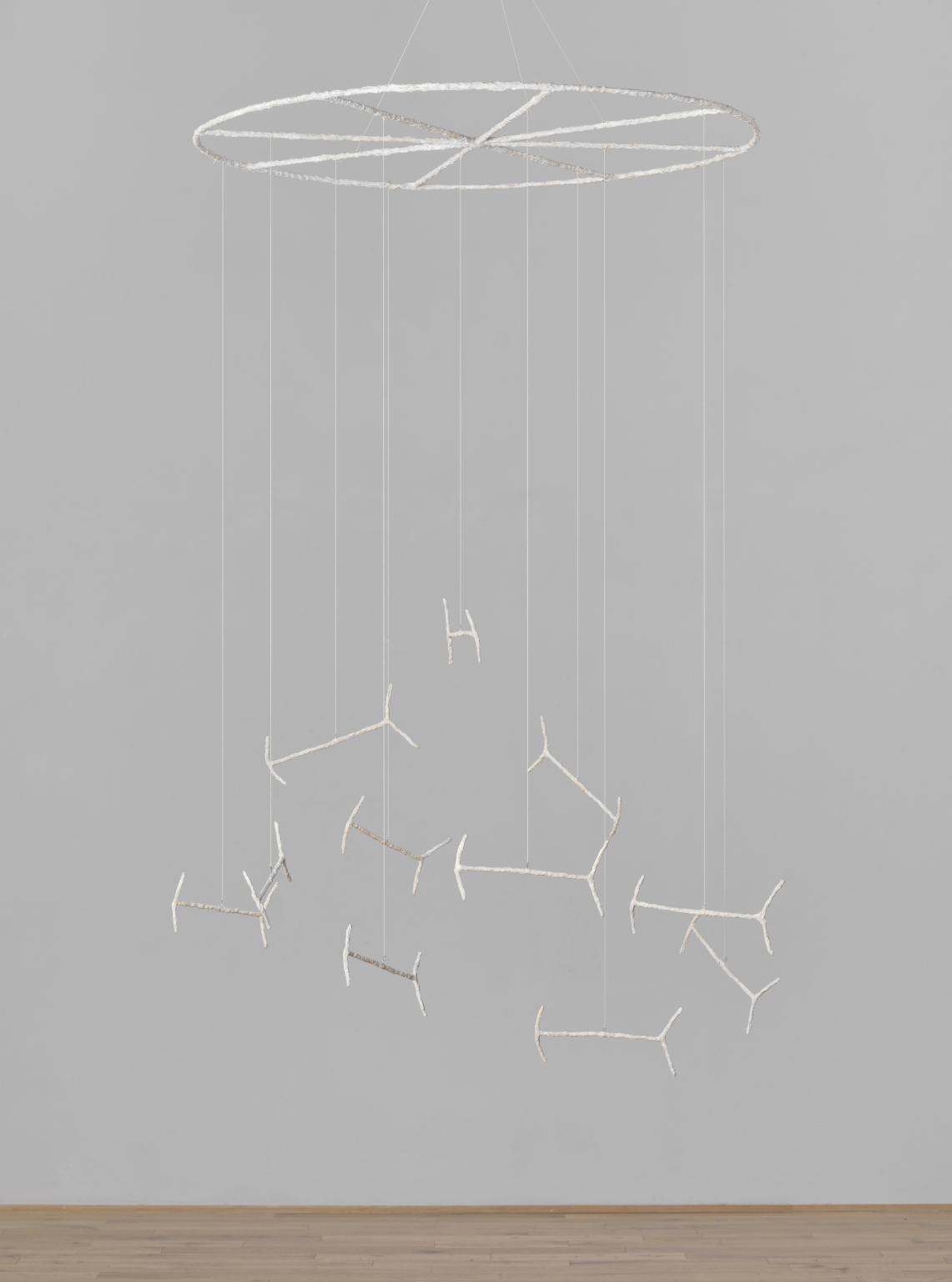
William Turnbull, Hanging Sculpture 1949
In this work, arrows or ‘fish’ shapes hang from a plaster-covered metal wheel. William Turnbull had been an RAF pilot and was fascinated by aerial views. He later described the diverse interests that fed into his work: ‘Movements in different planes at different speeds. I loved aquariums. Fish in tanks hanging in space and moving in shoals... I was obsessed with things in a state of balance.’ Turnbull made Hanging Sculpture in his studio in Paris and it was exhibited in London in 1950.
Gallery label, September 2023
11/26
artworks in Fear and Freedom
Unknown artist, The Keys; Millwood, New York: Kraus-Thomson Organization Limited 1976
12/26
artworks in Fear and Freedom
Roger Mayne, Group, St Stephen Gardens 1957
Roger Mayne taught himself photography, after studying chemistry at university. From 1956 he photographed people in Southam Street and the nearby St Stephen’s Gardens, near Notting Hill in West London. Mayne wrote about the working-class neighbourhood he documented: ‘The reason for photographing poor streets is that I love them... I remember my excitement when I turned the corner into Southam Street, a street I have since returned to again and again.’ Mayne was aware that photography doesn’t simply record real life, but constructs it. He said, ‘It is this particular mixture of reality and unreality, and the photographer’s power to select, that makes it possible for photography to be an art. Whether it is good art depends on the power and truth of the artist’s statement.’
Gallery label, September 2023
13/26
artworks in Fear and Freedom
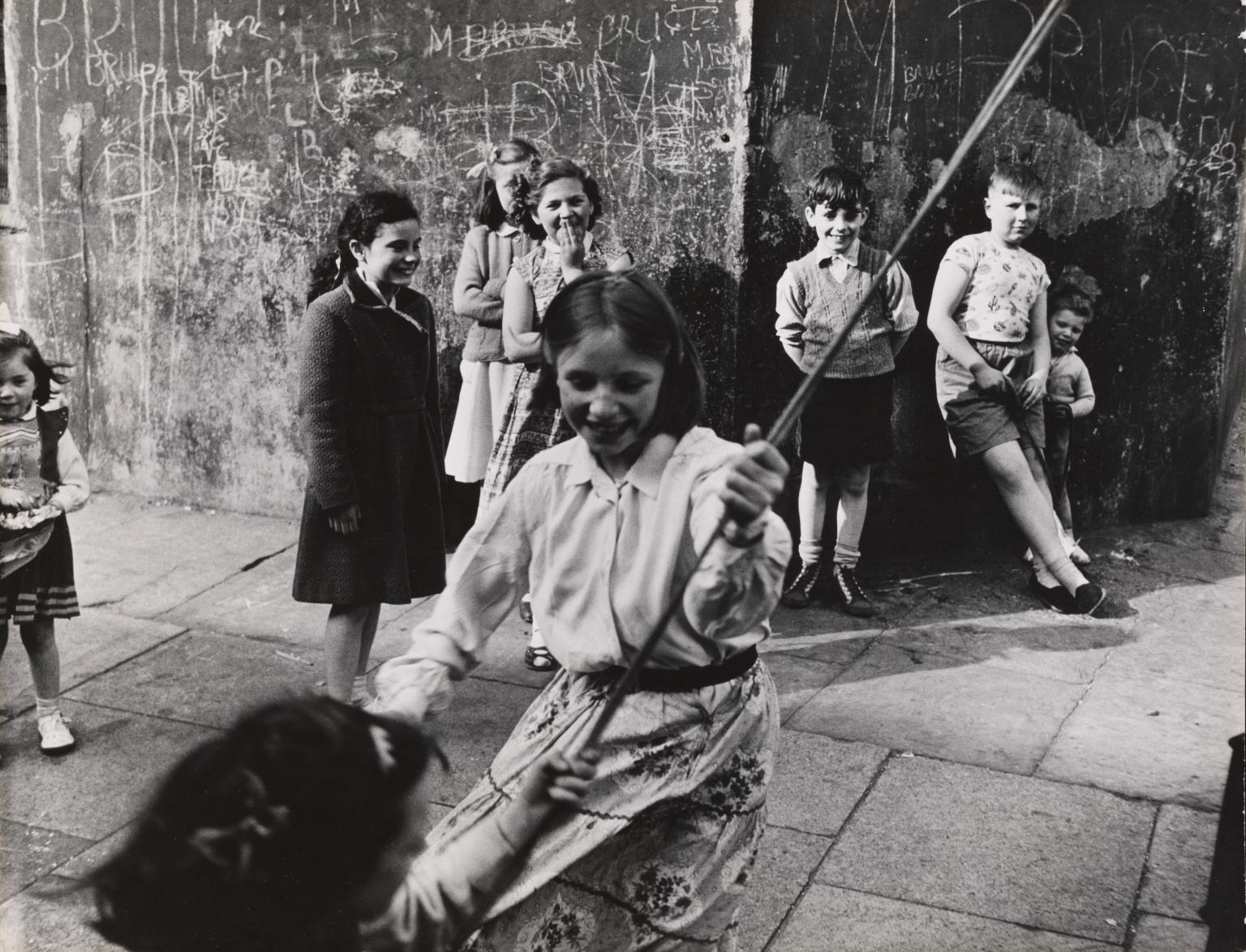
Roger Mayne, Girls swinging on a rope, Southam Street 1951
Roger Mayne taught himself photography, after studying chemistry at university. From 1956 he photographed people in Southam Street and the nearby St Stephen’s Gardens, near Notting Hill in West London. Mayne wrote about the working-class neighbourhood he documented: ‘The reason for photographing poor streets is that I love them... I remember my excitement when I turned the corner into Southam Street, a street I have since returned to again and again.’ Mayne was aware that photography doesn’t simply record real life, but constructs it. He said, ‘It is this particular mixture of reality and unreality, and the photographer’s power to select, that makes it possible for photography to be an art. Whether it is good art depends on the power and truth of the artist’s statement.’
Gallery label, September 2023
14/26
artworks in Fear and Freedom
Roger Mayne, West Indians, Southam Street 1956, printed 1998
Roger Mayne taught himself photography, after studying chemistry at university. From 1956 he photographed people in Southam Street and the nearby St Stephen’s Gardens, near Notting Hill in West London. Mayne wrote about the working-class neighbourhood he documented: ‘The reason for photographing poor streets is that I love them... I remember my excitement when I turned the corner into Southam Street, a street I have since returned to again and again.’ Mayne was aware that photography doesn’t simply record real life, but constructs it. He said, ‘It is this particular mixture of reality and unreality, and the photographer’s power to select, that makes it possible for photography to be an art. Whether it is good art depends on the power and truth of the artist’s statement.’
Gallery label, September 2023
15/26
artworks in Fear and Freedom
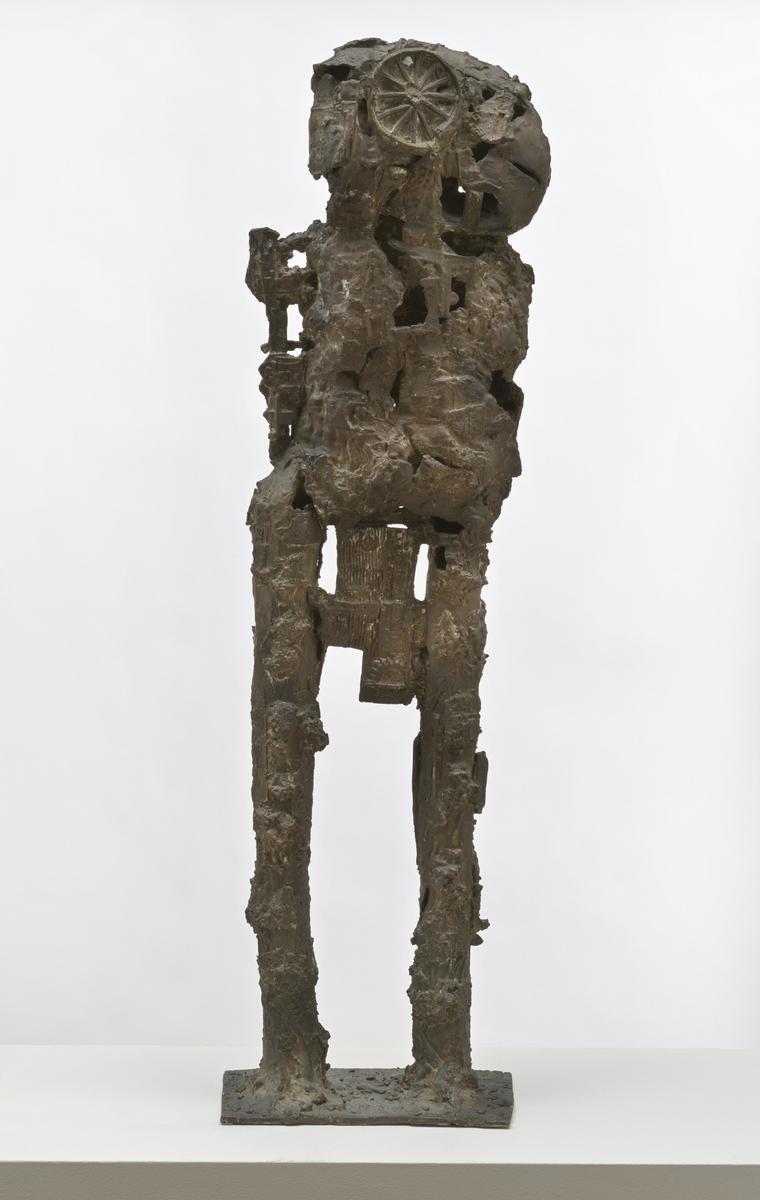
Sir Eduardo Paolozzi, Cyclops 1957
In classical mythology, the Cyclops was an immensely strong giant with a single eye in the centre of his forehead. The skin of this lumbering bronze figure is imprinted with broken machine-parts and other found debris. Paolozzi made it by pressing pieces of metal into a bed of moist clay, and then pouring molten wax into the clay mould. He constructed the model from these sheets of wax forms and finally cast it in bronze. Its pierced armour and dilapidated state has been seen as an ironic comment on the condition of man in the nuclear age.
Gallery label, September 2016
16/26
artworks in Fear and Freedom
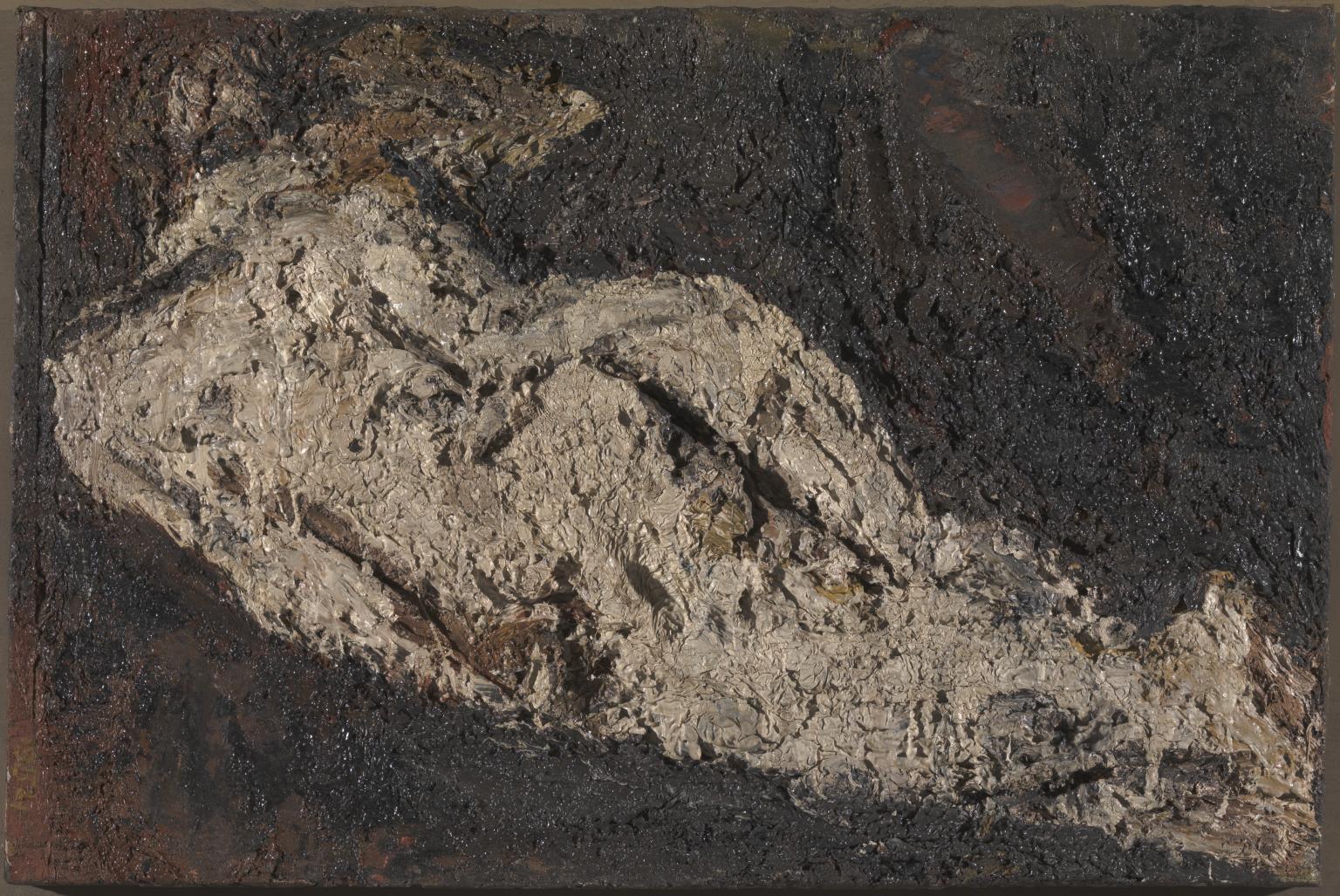
Frank Auerbach, E.O.W. Nude 1953–4
Frank Auerbach and Estella Olive West (E.O.W.) started a long relationship in 1948 when they were acting in the same play. She posed for him for over 20 years. This painting was executed over ten months of regular sittings. By applying oil paint over previous still-wet layers, Auerbach achieved a textured, almost sculptural rendering of the figure. Auerbach’s way of working creates a strong feeling of physical presence combined with a lively sense of process.
Gallery label, September 2023
17/26
artworks in Fear and Freedom
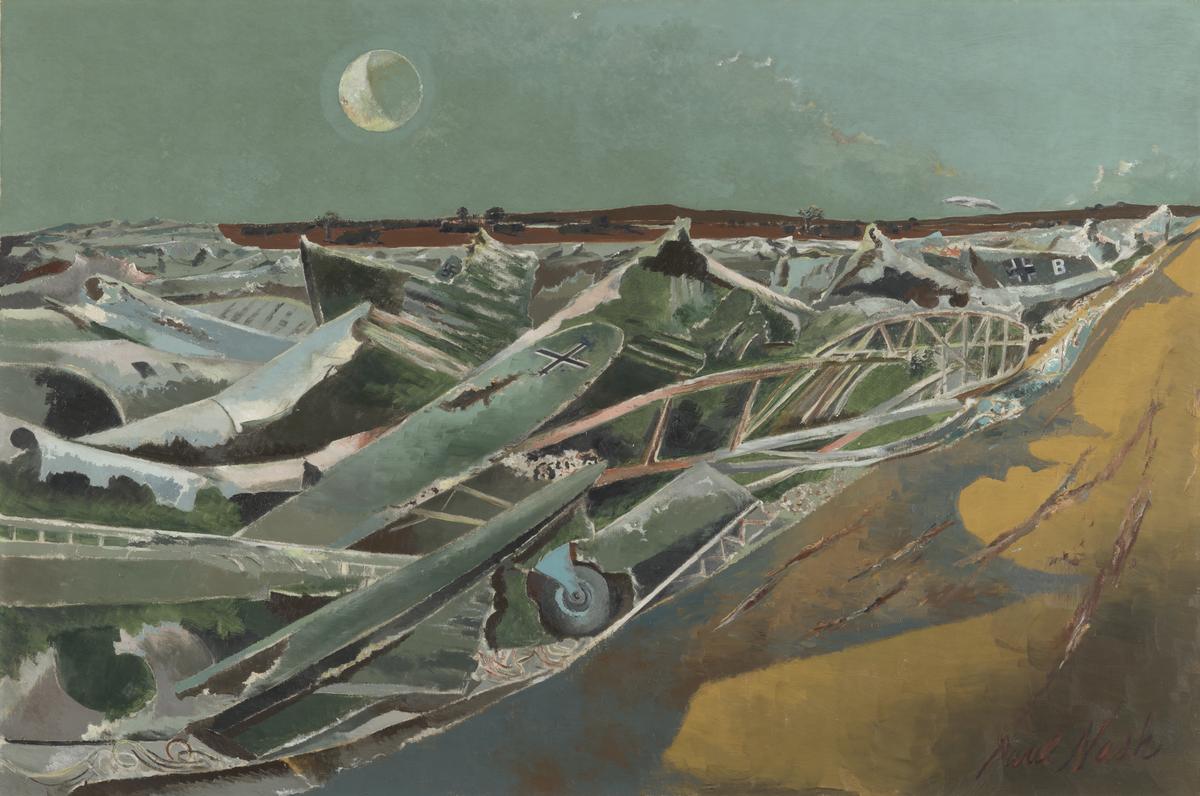
Paul Nash, Totes Meer (Dead Sea) 1940–1
Paul Nash painted this during the Second World War. It was inspired by a wrecked Luftwaffe aircraft dump at Cowley in Oxfordshire. He described the sight: ‘The thing looked to me suddenly like a great inundating sea... the breakers rearing up and crashing on the plain… nothing moves, it is not water or even ice, it is something static and dead.’ Nash, a British artist, chose to title the work in German.
Gallery label, September 2023
18/26
artworks in Fear and Freedom
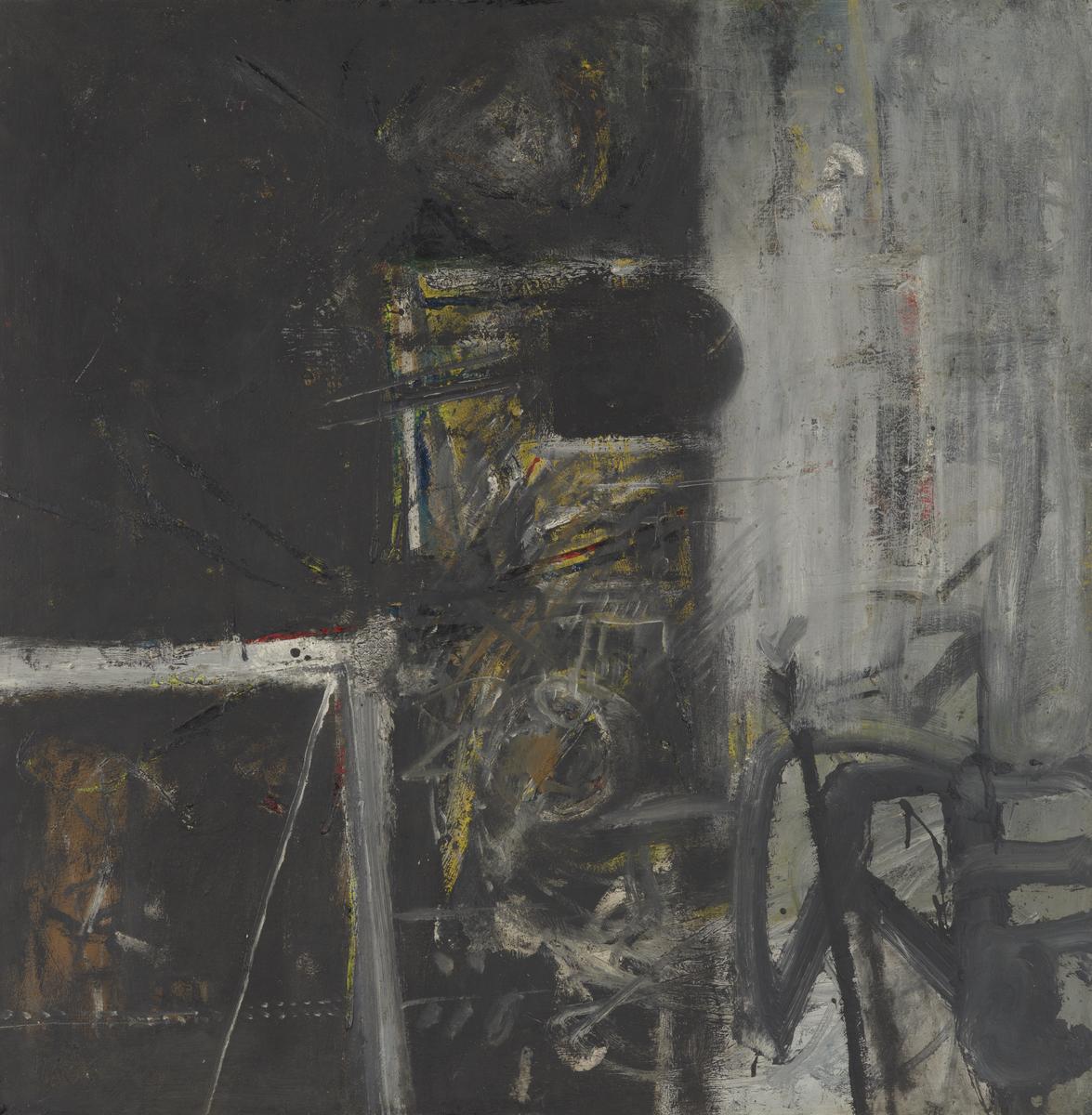
Alan Davie, Black Mirror 1952
Black had a special meaning for the artist following a brief illness in 1946 during which he was temporarily blind. He described this traumatic visual experience as 'whiteness'. In contrast black came to signify life and 'the depth of life'. Davie's usual practice at this time was to produce each painting swiftly and violently through a 'flash of inspiration'. If he was subsequently unhappy with the result he would begin again, obliterating the image with a completely new painting. Davie resisted the notion of pure abstraction and his title emphasises this. According to Davie 'here is a picture which you would call abstract but is a mirror in itself'.
Gallery label, September 2004
19/26
artworks in Fear and Freedom
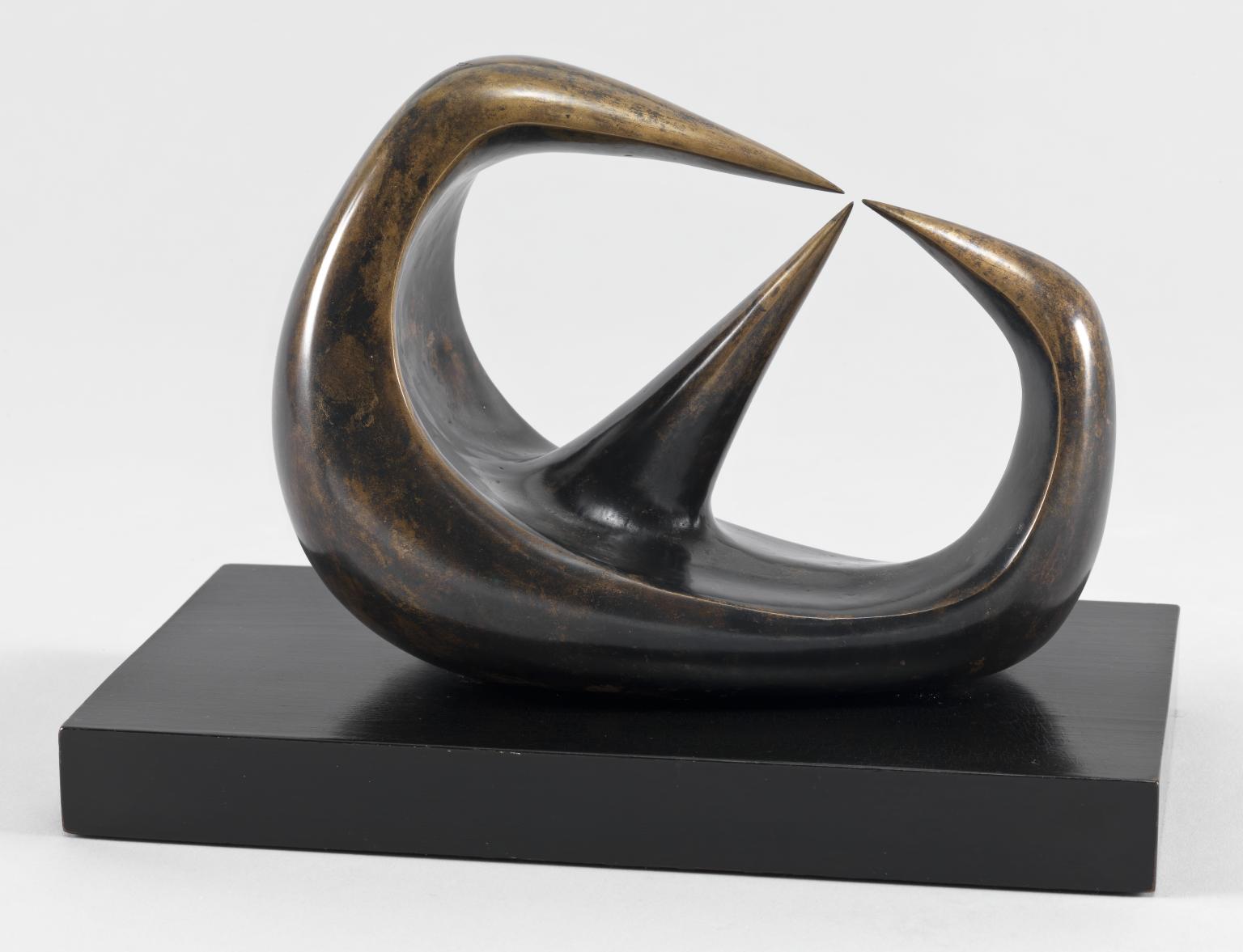
Henry Moore OM, CH, Three Points 1939–40, cast before 1949
Some art critics have interpreted Three Points as a threatening form. Others have seen it as an expression of sexual tension, in dialogue with surrealist imagery of the 1930s. Henry Moore himself commented: ‘This pointing has an emotional or physical action in it where things are just about to touch but don’t... like the points in the sparking plug of a car... the spark has to jump across the gap.’
Gallery label, September 2023
20/26
artworks in Fear and Freedom
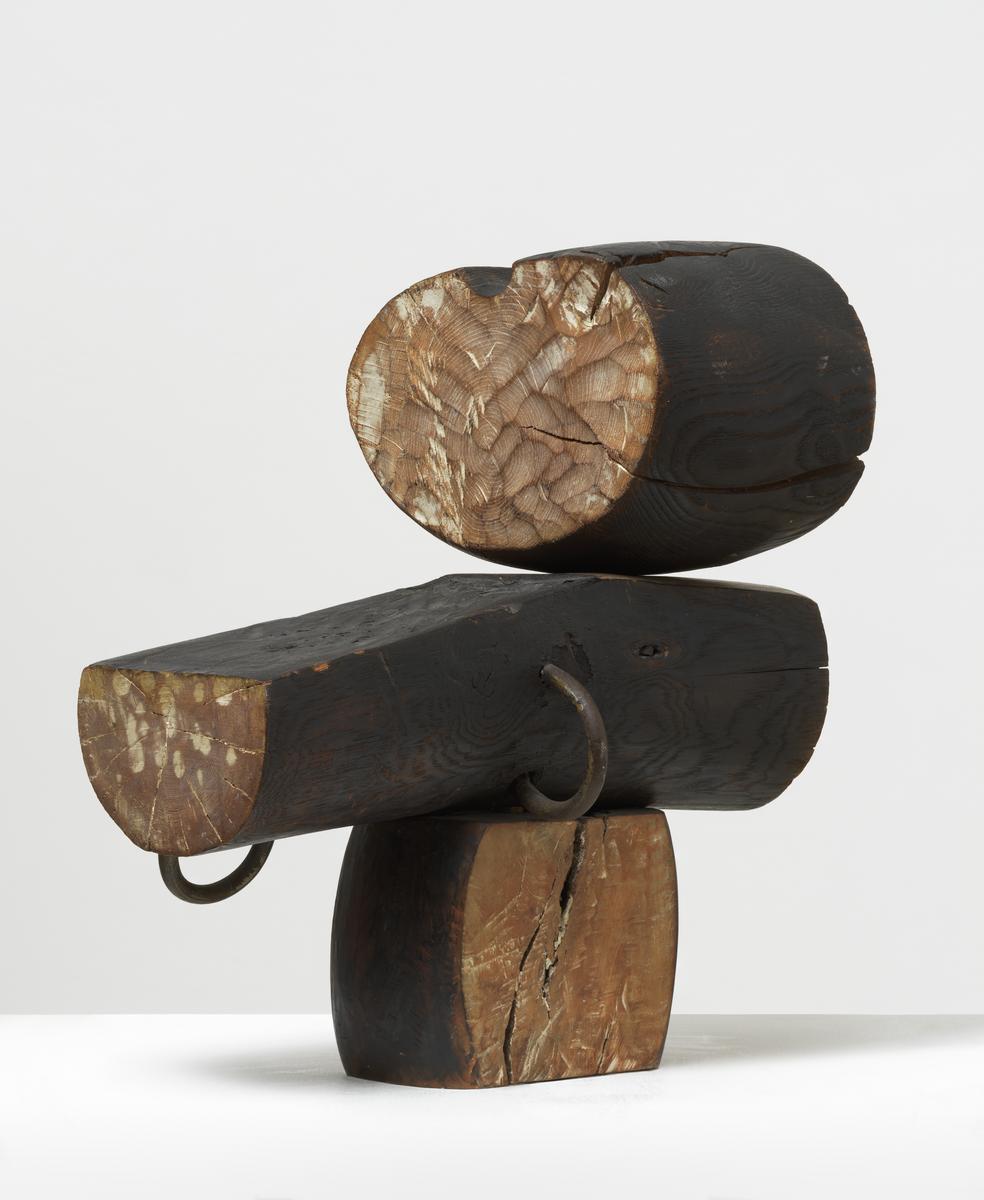
Kim Lim, Sphinx 1959
The title of this work speaks of Kim Lim’s love of ancient artefacts. It evokes a mythical hybrid creature, with the head of a human and the body of a lion. While still a student, Lim began to salvage, carve and assemble off-cuts she found in wood yards. This allowed her to create art from building blocks which already had forms and histories. She then combined them into bold and playful configurations. Here, Lim scorched the surface of the wood so different sections would have distinctive textures and reflect the light differently
Gallery label, September 2023
21/26
artworks in Fear and Freedom

Dame Barbara Hepworth, Pelagos 1946
Pelagos (‘sea’ in Greek) was inspired by a view of the bay at St Ives in Cornwall, where two stretches of land surround the sea on either side. The hollowed-out sculpture has a spiral form resembling a shell, a wave or the roll of a hill. Hepworth wanted the taut strings to express ‘the tension I felt between myself and the sea, the wind or the hills’. She moved to Cornwall with her husband, painter Ben Nicholson in 1939 and produced some of her best-known sculpture inspired by its wild landscape.
Gallery label, April 2019
22/26
artworks in Fear and Freedom
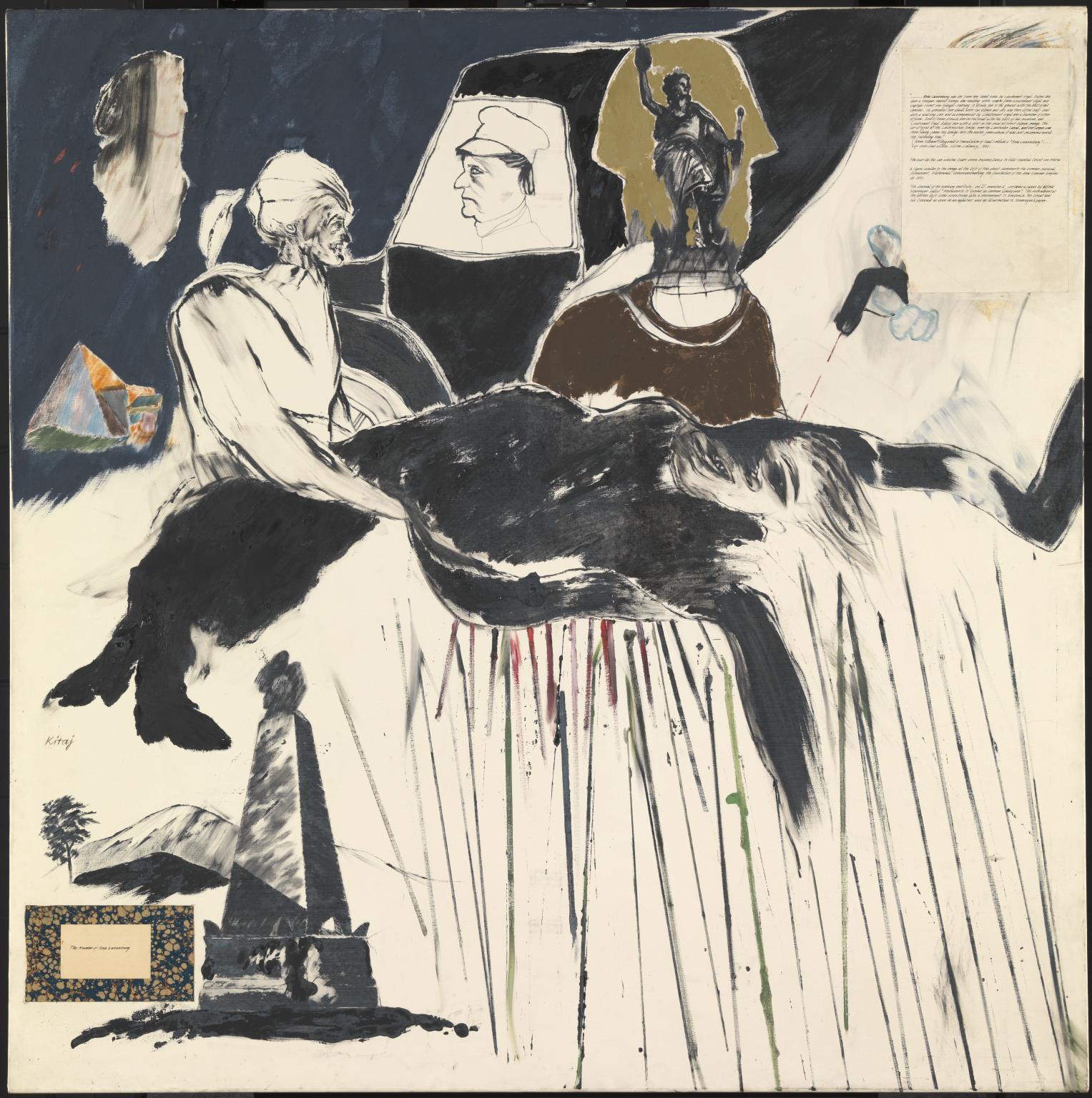
R.B. Kitaj, The Murder of Rosa Luxemburg 1960
Rosa Luxemburg was a Jewish activist and founder of the Communist Party of Germany (KPD). She was killed in 1919 by troops opposed to the revolutionary movement that swept Germany in the wake of the First World War. In the centre of the painting a figure holds Luxemburg’s corpse, while at top right is a collaged transcription of an account of the murder. Kitaj associated Luxemburg with his grandmother Helene, who was forced to flee Vienna in the 1930s. The veiled figure at top left represents his maternal grandmother, who fled Russia as a result of earlier pogroms of the Jewish people.
Gallery label, September 2018
23/26
artworks in Fear and Freedom
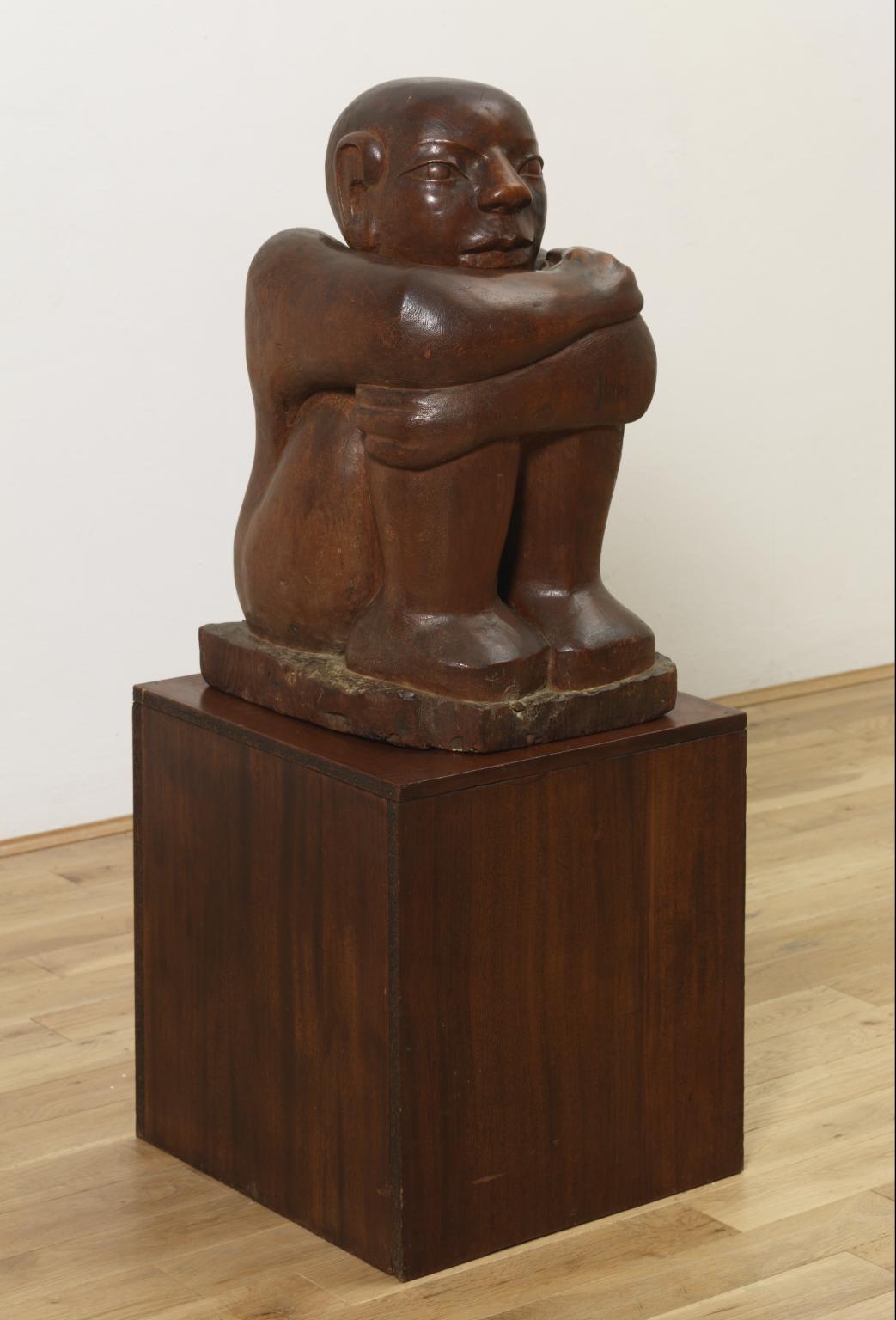
Ronald Moody, The Onlooker 1958–62
The Onlooker is Ronald Moody’s image of the artist’s role in society. He often used found pieces of wood. He carved this work from teak wood from a ship’s fender. Moody used the grain of the wood to direct his carving. The grain provides the lines of force that complement the stillness of the posture. It gives a sense of the animation of the mind. Moody said his work reflected his experience and presence in Europe and the Caribbean – a perpetual state of friction.
Gallery label, September 2023
24/26
artworks in Fear and Freedom
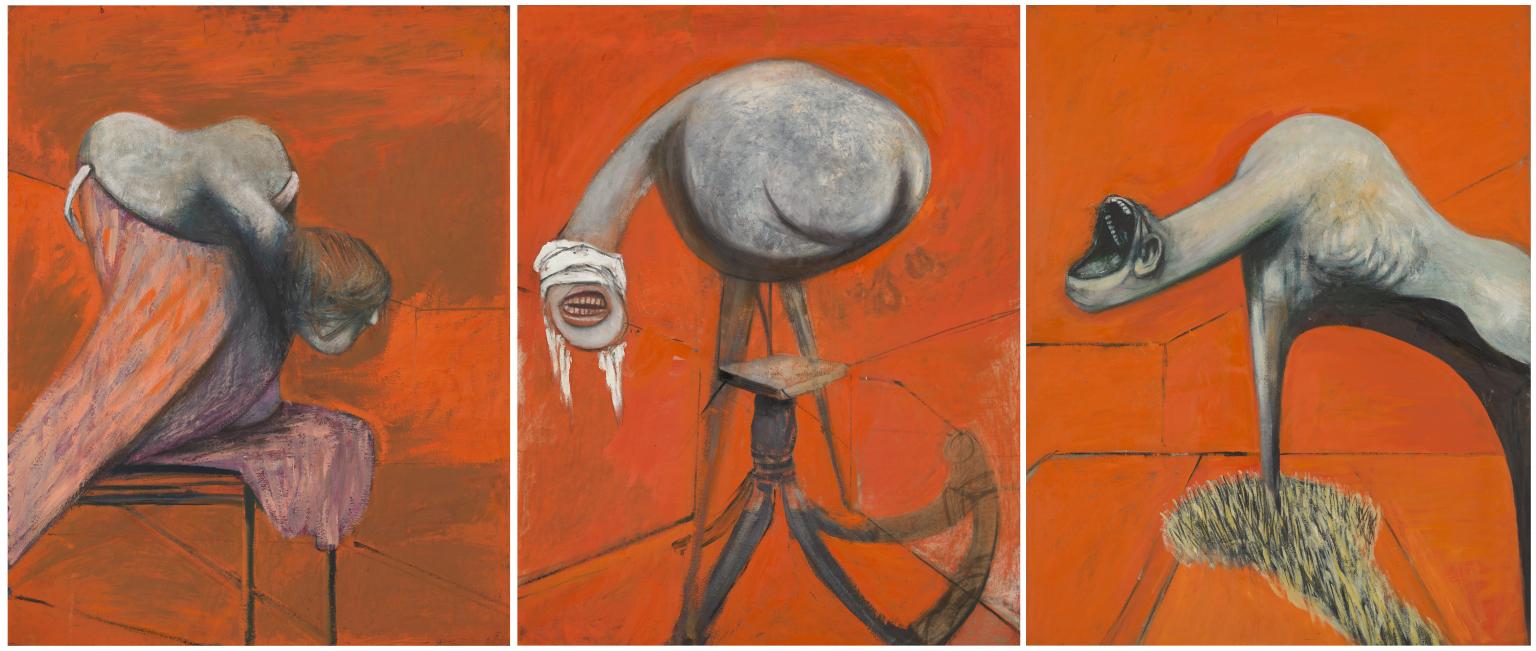
Francis Bacon, Three Studies for Figures at the Base of a Crucifixion 1944
Francis Bacon titled this work after the figures often featured in Christian paintings witnessing the death of Jesus. But he said the creatures represented the avenging Furies from Greek mythology. The Furies punish those who go against the natural order. In Aeschylus’s tragedy The Eumenides, for example, they pursue a man who has murdered his mother. Bacon first exhibited this painting in April 1945, towards the end of the Second World War. For some, it reflects the horror of the war and the Holocaust in a world lacking guiding principles.
Gallery label, September 2023
25/26
artworks in Fear and Freedom
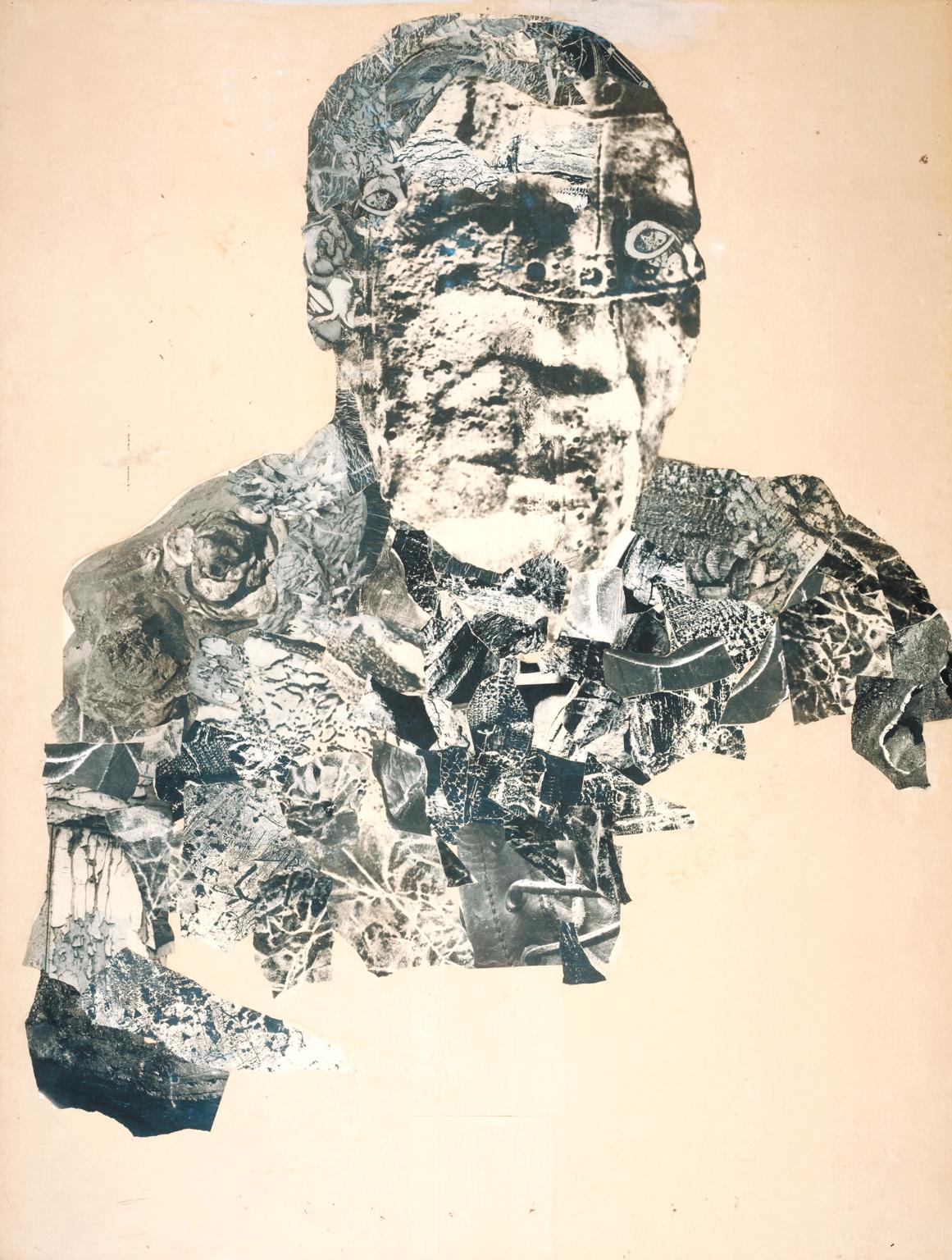
Nigel Henderson, Head of a Man 1956
Nigel Henderson made this work from layered photographs of vegetables, charred logs, stones, leaves, a shoe and a scratched wall. He described it as ‘Out of Nature and into Industry.’ Henderson began by making a smaller collage, which he photographed and enlarged. He then added more photographic cuttings and paint. Finally, he re-photographed and further enlarged the work to create this densely layered image. It was originally shown at the exhibition This is Tomorrow, Whitechapel Gallery, London in 1956.
Gallery label, September 2023
26/26
artworks in Fear and Freedom
Art in this room
Sorry, no image available










Sorry, no image available
Sorry, no image available

Sorry, no image available











You've viewed 6/26 artworks
You've viewed 26/26 artworks
